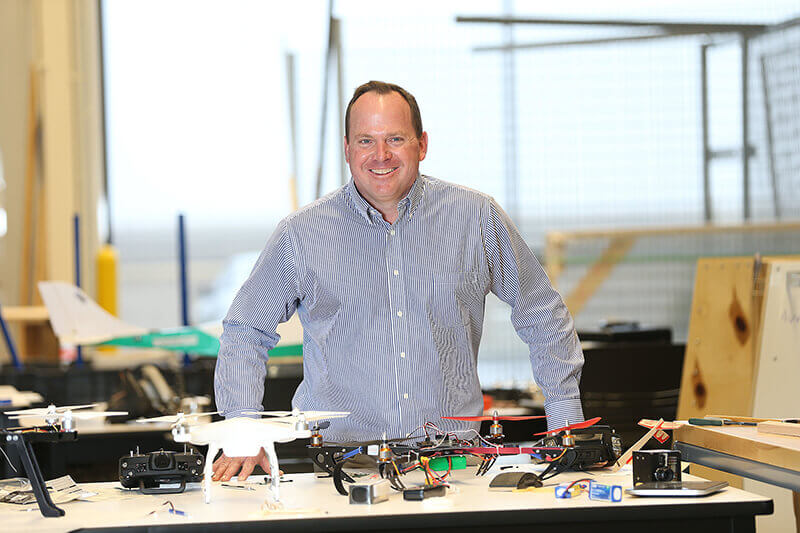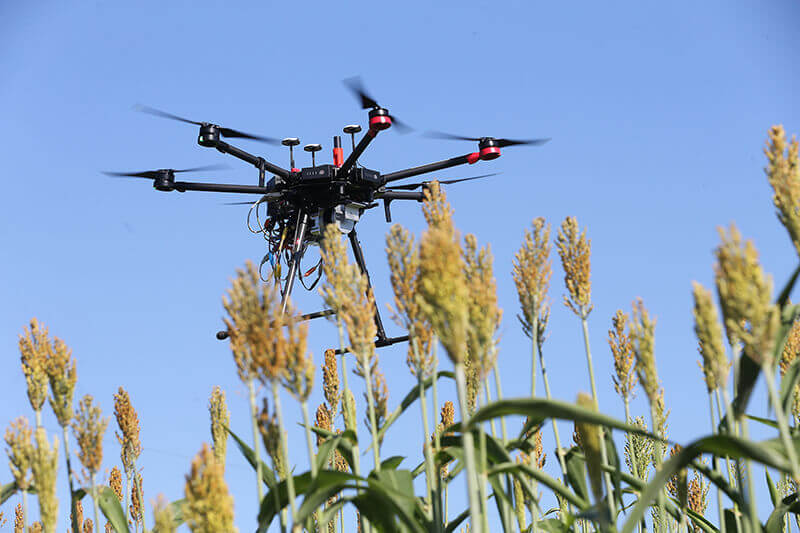November 4, 2019
$9 million from DOE, partners to take plant sensing from lab to market
 Purdue professor Mitch Tuinstra is leading the TERRA-2 research program, aimed at improving remote sensing for assessing plant traits and commercializing the technology. The sensors, which can be mounted to on-ground machinery or drones, can improve the efficiency and accuracy of phenotyping for plant breeders. (Purdue Agricultural Communication photos/Tom Campbell)
Download image
Purdue professor Mitch Tuinstra is leading the TERRA-2 research program, aimed at improving remote sensing for assessing plant traits and commercializing the technology. The sensors, which can be mounted to on-ground machinery or drones, can improve the efficiency and accuracy of phenotyping for plant breeders. (Purdue Agricultural Communication photos/Tom Campbell)
Download image
WEST LAFAYETTE, Ind. - Sending breeders into fields to manually measure the characteristics of plants is slow, laborious and expensive. Remote sensing technologies, coupled with advanced analytics, offer the promise of faster, more accurate data collection to improve the speed at which plant breeders can bring better cultivars to the market.
Purdue University scientists developed that technology under the Transportation Energy Resources from Renewable Agriculture (TERRA) program, through a $6.6 million U.S. Department of Energy Advanced Research Projects Agency–Energy (ARPA-E) grant awarded in 2015. The agency is funding a second phase of the TERRA project at $4.5 million that is being matched with another $4.5M from strategic partners, including AgAlumni Seed, Corteva Agriscience, Beck’s Hybrids and Headwall Photonics.
“Manual phenotyping is slow and costly. To do all of this measurement by hand takes a lot of people, and you don’t get a lot of data,” said Mitch Tuinstra, a Purdue professor of plant breeding and genetics, Wickersham Chair of Excellence in Agricultural Research, and principal investigator for the project. “Next-generation phenotyping technologies enable plant scientists and plant breeders to collect data automatically by remote sensing and process it using computational algorithms.”
 Sensing technology, including high-resolution RGB cameras, hyperspectral imaging, LIDAR and thermal infrared sensor, can improve the accuracy and efficiency of plant phenotyping. In a fraction of the time it would take researchers to manually measure plants in a field, sensors can assess plant height, canopy structure, plant architecture, biomass yield and more. (Purdue Agricultural Communication photos/Tom Campbell)
Download image
Sensing technology, including high-resolution RGB cameras, hyperspectral imaging, LIDAR and thermal infrared sensor, can improve the accuracy and efficiency of plant phenotyping. In a fraction of the time it would take researchers to manually measure plants in a field, sensors can assess plant height, canopy structure, plant architecture, biomass yield and more. (Purdue Agricultural Communication photos/Tom Campbell)
Download image
The platform developed under the TERRA project employs several types of sensors, including high-resolution RGB cameras as well as hyperspectral imaging, LIDAR and thermal infrared sensors. Together, they can be mounted to on-ground farm machinery or unmanned aerial vehicles (drones) to detect plant height, canopy structure, plant architecture, biomass yield and more.
The DOE is interested in the sensing platform to advance sorghum as a feedstock for cellulosic biofuels. The technology is robust enough, however, that it can be used for many other feed, fiber and biofuel crops.
To meet industry needs, Tuinstra and colleagues founded GRYFN, a startup aimed at getting the sensing technology into the hands of companies that can use it in their breeding programs. Its CEO, Matt Bechdol, said the company will connect with plant breeders to demonstrate the benefits of the technology and then use their input to improve the technology so that companies can make the best use of it.
“It capitalizes upon and empowers the Purdue plant science investment,” Bechdol said. “The technology is really about building a bridge between what is done in the lab and scaling it so that it can be performed in the field.”
Ag Alumni Seed, Indiana’s foundation seed company and a non-profit Purdue affiliate that is working with GRYFN, is eager to see remote sensing technology advances that can reduce input costs for its breeding program.
“When we send people into the field right now to do trial evaluation, we’re sending plant breeders with PhDs. Those are expensive employees. To have them spend multiple days walking trials, it’s an inefficient use of arguably our most valuable people,” said Jay Hulbert, Ag Alumni Seed president and CEO. “If we can get good data from a drone that either allows us to skip an evaluation or allows us to evaluate only the top 10 percent of the trials, then that’s a huge advantage. It would be a tremendous savings in time and resources for us.”
Melba Crawford, a professor of agronomy, civil engineering, and electrical and computer engineering, said next steps include developing more advanced models that incorporate additional inputs such as weather information, tillage practices, nitrogen availability, as well as the data acquired by the sensors.
“We are trying to make the models more robust and applicable to a wider range of climate and regional characteristics,” she said.
Writer: Brian Wallheimer, 765-532-0233, bwallhei@purdue.edu
Sources: Mitch Tuinstra, 765-494-9093, drmitch@purdue.edu
Melba Crawford, 765-496-9355, melbac@purdue.edu
Matt Bechdol, 260-553-9993, matt.bechdol@gryfn.io
Jay Hulbert, 765-538-3145, hulbert@agalumniseed.com
Agricultural Communications: 765-494-8415;
Maureen Manier, Department Head, mmanier@purdue.edu

